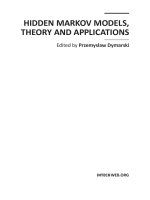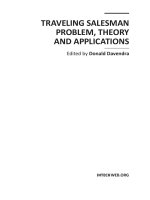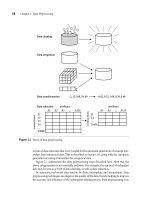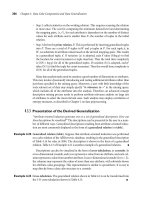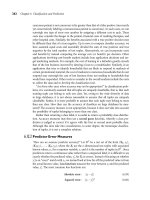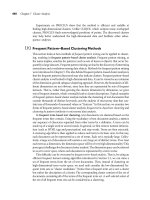Optimization based data mining theory and applications shi, tian, kou, peng li 2011 05 18
Bạn đang xem bản rút gọn của tài liệu. Xem và tải ngay bản đầy đủ của tài liệu tại đây (3.55 MB, 333 trang )
Advanced Information and Knowledge Processing
Series Editors
Professor Lakhmi Jain
Professor Xindong Wu
For other titles published in this series, go to
www.springer.com/series/4738
Yong Shi Yingjie Tian Gang Kou Yi Peng
Jianping Li
Optimization
Based Data
Mining: Theory
and Applications
Yong Shi
Research Center on Fictitious Economy and
Data Science
Chinese Academy of Sciences
Beijing 100190
China
and
College of Information Science &
Technology
University of Nebraska at Omaha
Omaha, NE 68182
USA
Yingjie Tian
Research Center on Fictitious Economy and
Data Science
Chinese Academy of Sciences
Beijing 100190
China
Gang Kou
School of Management and Economics
University of Electronic Science and
Technology of China
Chengdu 610054
China
Yi Peng
School of Management and Economics
University of Electronic Science and
Technology of China
Chengdu 610054
China
Jianping Li
Institute of Policy and Management
Chinese Academy of Sciences
Beijing 100190
China
ISSN 1610-3947
ISBN 978-0-85729-503-3
e-ISBN 978-0-85729-504-0
DOI 10.1007/978-0-85729-504-0
Springer London Dordrecht Heidelberg New York
British Library Cataloguing in Publication Data
A catalogue record for this book is available from the British Library
Library of Congress Control Number: 2011929129
© Springer-Verlag London Limited 2011
Apart from any fair dealing for the purposes of research or private study, or criticism or review, as permitted under the Copyright, Designs and Patents Act 1988, this publication may only be reproduced,
stored or transmitted, in any form or by any means, with the prior permission in writing of the publishers, or in the case of reprographic reproduction in accordance with the terms of licenses issued by the
Copyright Licensing Agency. Enquiries concerning reproduction outside those terms should be sent to
the publishers.
The use of registered names, trademarks, etc., in this publication does not imply, even in the absence of a
specific statement, that such names are exempt from the relevant laws and regulations and therefore free
for general use.
The publisher makes no representation, express or implied, with regard to the accuracy of the information
contained in this book and cannot accept any legal responsibility or liability for any errors or omissions
that may be made.
Cover design: deblik
Printed on acid-free paper
Springer is part of Springer Science+Business Media (www.springer.com)
This book is dedicated to the colleagues and
students who have worked with the authors
Preface
The purpose of this book is to provide up-to-date progress both in Multiple Criteria
Programming (MCP) and Support Vector Machines (SVMs) that have become powerful tools in the field of data mining. Most of the content in this book are directly
from the research and application activities that our research group has conducted
over the last ten years.
Although the data mining community is familiar with Vapnik’s SVM [206] in
classification, using optimization techniques to deal with data separation and data
analysis goes back more than fifty years. In the 1960s, O.L. Mangasarian formulated
the principle of large margin classifiers and tackled it using linear programming.
He and his colleagues have reformed his approaches in SVMs [141]. In the 1970s,
A. Charnes and W.W. Cooper initiated Data Envelopment Analysis, where linear or
quadratic programming is used to evaluate the efficiency of decision-making units
in a given training dataset. Started from the 1980s, F. Glover proposed a number
of linear programming models to solve the discriminant problem with a small-size
of dataset [75]. Since 1998, the author and co-authors of this book have not only
proposed and extended such a series of optimization-based classification models
via Multiple Criteria Programming (MCP), but also improved a number of SVM
related classification methods. These methods are different from statistics, decision
tree induction, and neural networks in terms of the techniques of separating data.
When MCP is used for classification, there are two common criteria. The first
one is the overlapping degree (e.g., norms of all overlapping) with respect to the
separating hyperplane. The lower this degree, the better the classification. The second is the distance from a point to the separating hyperplane. The larger the sum of
these distances, the better the classification. Accordingly, in linear cases, the objective of classification is either minimizing the sum of all overlapping or maximizing
the sum of the distances. MCP can also be viewed as extensions of SVM. Under
the framework of mathematical programming, both MCP and SVM share the same
advantage of using a hyperplane for separating the data. With certain interpretation,
MCP measures all possible distances from the training samples to separating hyperplane, while SVM only considers a fixed distance from the support vectors. This
allows MCP approaches to become an alternative for data separation.
vii
viii
Preface
As we all know, optimization lies at the heart of most data mining approaches.
Whenever data mining problems, such as classification and regression, are formulated by MCP or SVM, they can be reduced into different types of optimization
problems, including quadratic, linear, nonlinear, fuzzy, second-order cone, semidefinite, and semi-infinite programs.
This book mainly focuses on MCP and SVM, especially their recent theoretical
progress and real-life applications in various fields. Generally speaking, the book is
organized into three parts, and each part contains several related chapters. Part one
addresses some basic concepts and important theoretical topics on SVMs. It contains Chaps. 1, 2, 3, 4, 5, and 6. Chapter 1 reviews standard C-SVM for classification
problem and extends it to problems with nominal attributes. Chapter 2 introduces
LOO bounds for several algorithms of SVMs, which can speed up the process of
searching for appropriate parameters in SVMs. Chapters 3 and 4 consider SVMs for
multi-class, unsupervised, and semi-supervised problems by different mathematical programming models. Chapter 5 describes robust optimization models for several uncertain problems. Chapter 6 combines standard SVMs with feature selection
strategies at the same time via p-norm minimization where 0 < p < 1.
Part two mainly deals with MCP for data mining. Chapter 7 first introduces basic
concepts and models of MCP, and then constructs penalized Multiple Criteria Linear
Programming (MCLP) and regularized MCLP. Chapters 8, 9 and 11 describe several extensions of MCLP and Multiple Criteria Quadratic Programming (MCQP)
in order to build different models under various objectives and constraints. Chapter 10 provides non-additive measured MCLP when interactions among attributes
are allowed for classification.
Part three presents a variety of real-life applications of MCP and SVMs models.
Chapters 12, 13, and 14 are finance applications, including firm financial analysis, personal credit management and health insurance fraud detection. Chapters 15
and 16 are about web services, including network intrusion detection and the analysis for the pattern of lost VIP email customer accounts. Chapter 17 is related to
HIV-1 informatics for designing specific therapies, while Chap. 18 handles antigen and anti-body informatics. Chapter 19 concerns geochemical analyses. For the
convenience of the reader, each chapter of applications is self-contained and selfexplained.
Finally, Chap. 20 introduces the concept of intelligent knowledge management
first time and describes in detail the theoretical framework of intelligent knowledge.
The contents of this chapter go beyond the traditional domain of data mining and
look for how to produce knowledge support to the end users by combing hidden
patterns from data mining and human knowledge.
We are indebted to many people around the work for their encouragement and
kind support of our research on MCP and SVMs. We would like to thank Prof. Naiyang Deng (China Agricultural University), Prof. Wei-xuan Xu (Institute of Policy
and Management, Chinese Academy of Sciences), Prof. Zhengxin Chen (University of Nebraska at Omaha), Prof. Ling-ling Zhang (Graduate University of Chinese Academy of Sciences), Dr. Chun-hua Zhang (RenMin University of China),
Dr. Zhi-xia Yang (XinJiang University, China), and Dr. Kun Zhao (Beijing WuZi
University).
Preface
ix
In the last five years, there are a number of colleagues and graduate students at
the Research Center on Fictitious Economy and Data Science, Chinese Academy
of Sciences who contributed to our research projects as well as the preparation of
this book. Among them, we want to thank Dr. Xiao-fei Zhou, Dr. Ling-feng Niu,
Dr. Xing-sen Li, Dr. Peng Zhang, Dr. Dong-ling Zhang, Dr. Zhi-wang Zhang, Dr.
Yue-jin Zhang, Zhan Zhang, Guang-li Nie, Ruo-ying Chen, Zhong-bin OuYang,
Wen-jing Chen, Ying Wang, Yue-hua Zhang, Xiu-xiang Zhao, Rui Wang.
Finally, we would like acknowledge a number of funding agencies who provided their generous support to our research activities on this book. They are
First Data Corporation, Omaha, USA for the research fund “Multiple Criteria Decision Making in Credit Card Portfolio Management” (1998); the National Natural Science Foundation of China for the overseas excellent youth fund “Data
Mining in Bank Loan Risk Management” (#70028101, 2001–2003), the regular
project “Multiple Criteria Non-linear Based Data Mining Methods and Applications” (#70472074, 2005–2007), the regular project “Convex Programming Theory
and Methods in Data Mining” (#10601064, 2007–2009), the key project “Optimization and Data Mining” (#70531040, 2006–2009), the regular project “KnowledgeDriven Multi-criteria Decision Making for Data Mining: Theories and Applications” (#70901011, 2010–2012), the regular project “Towards Reliable Software:
A Standardize for Software Defects Measurement & Evaluation” (#70901015,
2010–2012), the innovative group grant “Data Mining and Intelligent Knowledge
Management” (#70621001, #70921061, 2007–2012); the President Fund of Graduate University of Chinese Academy of Sciences; the Global Economic Monitoring and Policy Simulation Pre-research Project, Chinese Academy of Sciences
(#KACX1-YW-0906, 2009–2011); US Air Force Research Laboratory for the contract “Proactive and Predictive Information Assurance for Next Generation Systems (P2INGS)” (#F30602-03-C-0247, 2003–2005); Nebraska EPScOR, the National Science Foundation of USA for industrial partnership fund “Creating Knowledge for Business Intelligence” (2009–2010); BHP Billiton Co., Australia for the
research fund “Data Mining for Petroleum Exploration” (2005–2010); Nebraska
Furniture Market—a unit of Berkshire Hathaway Investment Co., Omaha, USA for
the research fund “Revolving Charge Accounts Receivable Retrospective Analysis”
(2008–2009); and the CAS/SAFEA International Partnership Program for Creative
Research Teams “Data Science-Based Fictitious Economy and Environmental Policy Research” (2010–2012).
Chengdu, China
December 31, 2010
Yong Shi
Yingjie Tian
Gang Kou
Yi Peng
Jianping Li
Contents
Part I
Support Vector Machines: Theory and Algorithms
1
Support Vector Machines for Classification Problems . . . .
1.1 Method of Maximum Margin . . . . . . . . . . . . . . .
1.2 Dual Problem . . . . . . . . . . . . . . . . . . . . . . .
1.3 Soft Margin . . . . . . . . . . . . . . . . . . . . . . . .
1.4 C-Support Vector Classification . . . . . . . . . . . . . .
1.5 C-Support Vector Classification with Nominal Attributes
1.5.1 From Fixed Points to Flexible Points . . . . . . .
1.5.2 C-SVC with Nominal Attributes . . . . . . . . .
1.5.3 Numerical Experiments . . . . . . . . . . . . . .
.
.
.
.
.
.
.
.
.
.
.
.
.
.
.
.
.
.
.
.
.
.
.
.
.
.
.
.
.
.
.
.
.
.
.
.
.
.
.
.
.
.
.
.
.
3
3
5
6
8
10
10
11
12
2
LOO Bounds for Support Vector Machines . . . . . . . . . . .
2.1 Introduction . . . . . . . . . . . . . . . . . . . . . . . . . .
2.2 LOO Bounds for ε-Support Vector Regression . . . . . . . .
2.2.1 Standard ε-Support Vector Regression . . . . . . . .
2.2.2 The First LOO Bound . . . . . . . . . . . . . . . . .
2.2.3 A Variation of ε-Support Vector Regression . . . . .
2.2.4 The Second LOO Bound . . . . . . . . . . . . . . .
2.2.5 Numerical Experiments . . . . . . . . . . . . . . . .
2.3 LOO Bounds for Support Vector Ordinal Regression Machine
2.3.1 Support Vector Ordinal Regression Machine . . . . .
2.3.2 The First LOO Bound . . . . . . . . . . . . . . . . .
2.3.3 The Second LOO Bound . . . . . . . . . . . . . . .
2.3.4 Numerical Experiments . . . . . . . . . . . . . . . .
.
.
.
.
.
.
.
.
.
.
.
.
.
.
.
.
.
.
.
.
.
.
.
.
.
.
.
.
.
.
.
.
.
.
.
.
.
.
.
15
15
16
16
17
26
27
30
32
33
38
42
44
3
Support Vector Machines for Multi-class Classification Problems
3.1 K-Class Linear Programming Support Vector Classification
Regression Machine (K-LPSVCR) . . . . . . . . . . . . . . .
3.1.1 K-LPSVCR . . . . . . . . . . . . . . . . . . . . . . .
3.1.2 Numerical Experiments . . . . . . . . . . . . . . . . .
3.1.3 ν-K-LPSVCR . . . . . . . . . . . . . . . . . . . . . .
. .
47
.
.
.
.
47
49
50
52
.
.
.
.
xi
xii
Contents
3.2 Support Vector Ordinal Regression Machine for Multi-class
Problems . . . . . . . . . . . . . . . . . . . . . . . . . . . .
3.2.1 Kernel Ordinal Regression for 3-Class Problems . . .
3.2.2 Multi-class Classification Algorithm . . . . . . . . .
3.2.3 Numerical Experiments . . . . . . . . . . . . . . . .
4
5
6
Unsupervised and Semi-supervised Support Vector Machines .
4.1 Unsupervised and Semi-supervised ν-Support
Vector Machine . . . . . . . . . . . . . . . . . . . . . . . .
4.1.1 Bounded ν-Support Vector Machine . . . . . . . . .
4.1.2 ν-SDP for Unsupervised Classification Problems . . .
4.1.3 ν-SDP for Semi-supervised Classification Problems .
4.2 Numerical Experiments . . . . . . . . . . . . . . . . . . . .
4.2.1 Numerical Experiments of Algorithm 4.2 . . . . . . .
4.2.2 Numerical Experiments of Algorithm 4.3 . . . . . . .
4.3 Unsupervised and Semi-supervised Lagrange Support Vector
Machine . . . . . . . . . . . . . . . . . . . . . . . . . . . .
4.4 Unconstrained Transductive Support Vector Machine . . . .
4.4.1 Transductive Support Vector Machine . . . . . . . . .
4.4.2 Unconstrained Transductive Support Vector Machine
4.4.3 Unconstrained Transductive Support Vector Machine
with Kernels . . . . . . . . . . . . . . . . . . . . . .
.
.
.
.
.
.
.
.
54
54
56
57
. . .
61
.
.
.
.
.
.
.
.
.
.
.
.
.
.
.
.
.
.
.
.
.
62
62
63
65
66
66
67
.
.
.
.
.
.
.
.
.
.
.
.
69
72
73
74
. . .
77
Robust Support Vector Machines . . . . . . . . . . . . . . . . . .
5.1 Robust Support Vector Ordinal Regression Machine . . . . . .
5.2 Robust Multi-class Algorithm . . . . . . . . . . . . . . . . . .
5.3 Numerical Experiments . . . . . . . . . . . . . . . . . . . . .
5.3.1 Numerical Experiments of Algorithm 5.6 . . . . . . . .
5.3.2 Numerical Experiments of Algorithm 5.7 . . . . . . . .
5.4 Robust Unsupervised and Semi-supervised Bounded C-Support
Vector Machine . . . . . . . . . . . . . . . . . . . . . . . . .
5.4.1 Robust Linear Optimization . . . . . . . . . . . . . . .
5.4.2 Robust Algorithms with Polyhedron . . . . . . . . . .
5.4.3 Robust Algorithm with Ellipsoid . . . . . . . . . . . .
5.4.4 Numerical Results . . . . . . . . . . . . . . . . . . . .
Feature Selection via lp -Norm Support Vector Machines .
6.1 lp -Norm Support Vector Classification . . . . . . . . .
6.1.1 lp -SVC . . . . . . . . . . . . . . . . . . . . . .
6.1.2 Lower Bound for Nonzero Entries in Solutions
of lp -SVC . . . . . . . . . . . . . . . . . . . .
6.1.3 Iteratively Reweighted lq -SVC for lp -SVC . . .
6.2 lp -Norm Proximal Support Vector Machine . . . . . . .
6.2.1 Lower Bounds for Nonzero Entries in Solutions
of lp -PSVM . . . . . . . . . . . . . . . . . . .
6.2.2 Smoothing lp -PSVM Problem . . . . . . . . . .
6.2.3 Numerical Experiments . . . . . . . . . . . . .
.
.
.
.
.
.
.
.
.
.
.
.
.
.
.
.
81
81
93
94
94
95
.
.
.
.
.
. 96
. 97
. 97
. 101
. 103
. . . . . . 107
. . . . . . 107
. . . . . . 108
. . . . . . 109
. . . . . . 111
. . . . . . 111
. . . . . . 113
. . . . . . 113
. . . . . . 114
Contents
Part II
7
8
9
xiii
Multiple Criteria Programming: Theory and Algorithms
Multiple Criteria Linear Programming . . . . . . . . . . . . . . .
7.1 Comparison of Support Vector Machine and Multiple Criteria
Programming . . . . . . . . . . . . . . . . . . . . . . . . . .
7.2 Multiple Criteria Linear Programming . . . . . . . . . . . . .
7.3 Multiple Criteria Linear Programming for Multiple Classes . .
7.4 Penalized Multiple Criteria Linear Programming . . . . . . . .
7.5 Regularized Multiple Criteria Linear Programs
for Classification . . . . . . . . . . . . . . . . . . . . . . . . .
MCLP Extensions . . . . . . . . . . . . . . . . . . . . . .
8.1 Fuzzy MCLP . . . . . . . . . . . . . . . . . . . . . . .
8.2 FMCLP with Soft Constraints . . . . . . . . . . . . . .
8.3 FMCLP by Tolerances . . . . . . . . . . . . . . . . . .
8.4 Kernel-Based MCLP . . . . . . . . . . . . . . . . . . .
8.5 Knowledge-Based MCLP . . . . . . . . . . . . . . . .
8.5.1 Linear Knowledge-Based MCLP . . . . . . . .
8.5.2 Nonlinear Knowledge and Kernel-Based MCLP
8.6 Rough Set-Based MCLP . . . . . . . . . . . . . . . . .
8.6.1 Rough Set-Based Feature Selection Method . .
8.6.2 A Rough Set-Based MCLP Approach
for Classification . . . . . . . . . . . . . . . . .
8.7 Regression by MCLP . . . . . . . . . . . . . . . . . .
.
.
.
.
.
.
.
.
.
.
Multiple Criteria Quadratic Programming . . . . . . . .
9.1 A General Multiple Mathematical Programming . . .
9.2 Multi-criteria Convex Quadratic Programming Model
9.3 Kernel Based MCQP . . . . . . . . . . . . . . . . . .
.
.
.
.
.
.
.
.
.
.
.
.
.
.
.
.
.
.
.
.
.
.
.
.
.
.
.
.
.
.
.
.
.
.
.
.
.
.
. . 119
.
.
.
.
.
.
.
.
119
120
123
129
. . 129
.
.
.
.
.
.
.
.
.
.
.
.
.
.
.
.
.
.
.
.
133
133
136
140
141
143
143
147
150
150
. . . . . . 152
. . . . . . 155
.
.
.
.
.
.
.
.
.
.
.
.
.
.
.
.
.
.
.
.
157
157
161
167
10 Non-additive MCLP . . . . . . . . . . . . . . . . . . . . . . . .
10.1 Non-additive Measures and Integrals . . . . . . . . . . . . .
10.2 Non-additive Classification Models . . . . . . . . . . . . . .
10.3 Non-additive MCP . . . . . . . . . . . . . . . . . . . . . . .
10.4 Reducing the Time Complexity . . . . . . . . . . . . . . . .
10.4.1 Hierarchical Choquet Integral . . . . . . . . . . . . .
10.4.2 Choquet Integral with Respect to k-Additive Measure
.
.
.
.
.
.
.
.
.
.
.
.
.
.
.
.
.
.
.
.
.
171
171
172
178
179
179
180
11 MC2LP . . . . . . . . . . . . . . . . . . . . . . . . . . . . . . .
11.1 MC2LP Classification . . . . . . . . . . . . . . . . . . . . .
11.1.1 Multiple Criteria Linear Programming . . . . . . . .
11.1.2 Different Versions of MC2 . . . . . . . . . . . . . .
11.1.3 Heuristic Classification Algorithm . . . . . . . . . .
11.2 Minimal Error and Maximal Between-Class Variance Model .
.
.
.
.
.
.
.
.
.
.
.
.
.
.
.
.
.
.
183
183
183
186
189
191
xiv
Contents
Part III Applications in Various Fields
12 Firm Financial Analysis . . . . .
12.1 Finance and Banking . . . . .
12.2 General Classification Process
12.3 Firm Bankruptcy Prediction .
.
.
.
.
.
.
.
.
.
.
.
.
.
.
.
.
.
.
.
.
.
.
.
.
.
.
.
.
.
.
.
.
.
.
.
.
.
.
.
.
.
.
.
.
.
.
.
.
.
.
.
.
.
.
.
.
.
.
.
.
.
.
.
.
.
.
.
.
.
.
.
.
.
.
.
.
.
.
.
.
195
195
196
199
13 Personal Credit Management . . . . . . . . . . . . . . .
13.1 Credit Card Accounts Classification . . . . . . . . . .
13.2 Two-Class Analysis . . . . . . . . . . . . . . . . . .
13.2.1 Six Different Methods . . . . . . . . . . . . .
13.2.2 Implication of Business Intelligence
and Decision Making . . . . . . . . . . . . .
13.2.3 FMCLP Analysis . . . . . . . . . . . . . . .
13.3 Three-Class Analysis . . . . . . . . . . . . . . . . .
13.3.1 Three-Class Formulation . . . . . . . . . . .
13.3.2 Small Sample Testing . . . . . . . . . . . . .
13.3.3 Real-Life Data Analysis . . . . . . . . . . . .
13.4 Four-Class Analysis . . . . . . . . . . . . . . . . . .
13.4.1 Four-Class Formulation . . . . . . . . . . . .
13.4.2 Empirical Study and Managerial Significance
of Four-Class Models . . . . . . . . . . . . .
.
.
.
.
.
.
.
.
.
.
.
.
.
.
.
.
.
.
.
.
.
.
.
.
.
.
.
.
203
203
207
207
.
.
.
.
.
.
.
.
.
.
.
.
.
.
.
.
.
.
.
.
.
.
.
.
.
.
.
.
.
.
.
.
.
.
.
.
.
.
.
.
.
.
.
.
.
.
.
.
.
.
.
.
.
.
.
.
211
213
219
219
222
227
228
228
. . . . . . . 230
14 Health Insurance Fraud Detection . . . . . . . . . . . . . . . . . . . 233
14.1 Problem Identification . . . . . . . . . . . . . . . . . . . . . . . . 233
14.2 A Real-Life Data Mining Study . . . . . . . . . . . . . . . . . . . 233
15 Network Intrusion Detection . . . . . . . . . . . . . . . . .
15.1 Problem and Two Datasets . . . . . . . . . . . . . . . . .
15.2 Classify NeWT Lab Data by MCMP, MCMP with Kernel
and See5 . . . . . . . . . . . . . . . . . . . . . . . . . .
15.3 Classify KDDCUP-99 Data by Nine Different Methods .
16 Internet Service Analysis . . . . . . . . . . . . . . . . . . .
16.1 VIP Mail Dataset . . . . . . . . . . . . . . . . . . . . .
16.2 Empirical Study of Cross-Validation . . . . . . . . . .
16.3 Comparison of Multiple-Criteria Programming Models
and SVM . . . . . . . . . . . . . . . . . . . . . . . . .
. . . . . 237
. . . . . 237
. . . . . 239
. . . . . 240
. . . . . . 243
. . . . . . 243
. . . . . . 244
. . . . . . 247
17 HIV-1 Informatics . . . . . . . . . . . . . . . . . . . . . . . .
17.1 HIV-1 Mediated Neuronal Dendritic and Synaptic Damage
17.2 Materials and Methods . . . . . . . . . . . . . . . . . . . .
17.2.1 Neuronal Culture and Treatments . . . . . . . . . .
17.2.2 Image Analysis . . . . . . . . . . . . . . . . . . .
17.2.3 Preliminary Analysis of Neuronal Damage Induced
by HIV MCM Treated Neurons . . . . . . . . . . .
17.2.4 Database . . . . . . . . . . . . . . . . . . . . . . .
17.3 Designs of Classifications . . . . . . . . . . . . . . . . . .
.
.
.
.
.
.
.
.
.
.
.
.
.
.
.
.
.
.
.
.
249
249
251
251
252
. . . . 252
. . . . 253
. . . . 254
Contents
xv
17.4 Analytic Results . . . . . . . . . . . . . . . . . . . . . . . . . . . 256
17.4.1 Empirical Classification . . . . . . . . . . . . . . . . . . . 256
18 Anti-gen and Anti-body Informatics . . . .
18.1 Problem Background . . . . . . . . . .
18.2 MCQP, LDA and DT Analyses . . . . .
18.3 Kernel-Based MCQP and SVM Analyses
.
.
.
.
.
.
.
.
.
.
.
.
.
.
.
.
.
.
.
.
.
.
.
.
.
.
.
.
.
.
.
.
.
.
.
.
.
.
.
.
.
.
.
.
.
.
.
.
.
.
.
.
.
.
.
.
259
259
260
266
19 Geochemical Analyses . . . . . . . .
19.1 Problem Description . . . . . . .
19.2 Multiple-Class Analyses . . . . .
19.2.1 Two-Class Classification .
19.2.2 Three-Class Classification
19.2.3 Four-Class Classification
19.3 More Advanced Analyses . . . .
.
.
.
.
.
.
.
.
.
.
.
.
.
.
.
.
.
.
.
.
.
.
.
.
.
.
.
.
.
.
.
.
.
.
.
.
.
.
.
.
.
.
.
.
.
.
.
.
.
.
.
.
.
.
.
.
.
.
.
.
.
.
.
.
.
.
.
.
.
.
.
.
.
.
.
.
.
.
.
.
.
.
.
.
.
.
.
.
.
.
.
.
.
.
.
.
.
.
269
269
270
270
271
271
272
.
.
.
.
.
.
.
.
.
.
.
.
.
.
.
.
.
.
.
.
.
.
.
.
.
.
.
.
20 Intelligent Knowledge Management . . . . . . . . . . . . . . .
20.1 Purposes of the Study . . . . . . . . . . . . . . . . . . . . .
20.2 Definitions and Theoretical Framework
of Intelligent Knowledge . . . . . . . . . . . . . . . . . . .
20.2.1 Key Concepts and Definitions . . . . . . . . . . . . .
20.2.2 4T Process and Major Steps of Intelligent Knowledge
Management . . . . . . . . . . . . . . . . . . . . . .
20.3 Some Research Directions . . . . . . . . . . . . . . . . . . .
20.3.1 The Systematic Theoretical Framework of Data
Technology and Intelligent Knowledge Management .
20.3.2 Measurements of Intelligent Knowledge . . . . . . .
20.3.3 Intelligent Knowledge Management System Research
. . . 277
. . . 277
. . . 280
. . . 280
. . . 288
. . . 290
. . . 291
. . . 292
. . . 293
Bibliography . . . . . . . . . . . . . . . . . . . . . . . . . . . . . . . . . . 295
Subject Index . . . . . . . . . . . . . . . . . . . . . . . . . . . . . . . . . . 307
Author Index . . . . . . . . . . . . . . . . . . . . . . . . . . . . . . . . . . 311
Part I
Support Vector Machines:
Theory and Algorithms
Chapter 1
Support Vector Machines for Classification
Problems
Support vector machines (SVMs), introduced by Vapnik in the early 1990’s
[23, 206], are powerful techniques for machine learning and data mining. Recent
breakthroughs have led to advancements in the theory and applications. SVMs were
developed to solve the classification problem at first, but they have been extended
to the domain of regression [198], clustering problems [243, 245]. Such standard
SVMs require the solution of either a quadratic or a linear programming.
The classification problem can be restricted to considering the two-class problem
without loss of generality. It can be described as follows: suppose that two classes
of objects are given, we are then faced a new object, and have to assign it to one of
the two classes.
This problem is formulated mathematically [53]: Given a training set
T = {(x1 , y1 ), . . . , (xl , yl )} ∈ (R n × {−1, 1})l ,
(1.1)
where xi = ([xi ]1 , . . . , [xi ]n )T is called an input with the attributes [xi ]j , j =
1, . . . , n, and yi = −1 or 1 is called the corresponding output, i = 1, . . . , l. The
¯
question is, for a new input x¯ = ([x¯1 ], . . . , [x¯ n ])T , to find its corresponding y.
1.1 Method of Maximum Margin
Consider the example in Fig. 1.1. Here the problem is called linearly separable because that the set of training vectors (points) belong to two separated classes, there
are many possible lines that can separate the data. Let us discuss which line is better.
Suppose that the direction of the line is given, just as the w in Fig. 1.2. We can see
that line l1 with direction w can separate the points correctly. If we put l1 right-up
and left-down until l1 touches some points of each class, we will get two “support”
lines l2 and l3 , all the lines parallel to and between them can separate the points
correctly also. Obviously the middle line l is the “best”.
Y. Shi et al., Optimization Based Data Mining: Theory and Applications,
Advanced Information and Knowledge Processing,
DOI 10.1007/978-0-85729-504-0_1, © Springer-Verlag London Limited 2011
3
4
1 Support Vector Machines for Classification Problems
Fig. 1.1 Linearly separable
problem
Fig. 1.2 Two support lines
with fixed direction
Fig. 1.3 The direction with
maximum margin
Now how to choose the direction w of the line? Just as the description above, for a
given w, we will get two support lines, the distance between them is called “margin”
corresponding to w. We can image that the direction with maximum margin should
be chosen, as in Fig. 1.3.
1.2 Dual Problem
5
If the equation of the separating line is given as
(w · x) + b = 0,
(1.2)
there is some redundancy in (1.2), and without loss of generality it is appropriate to
consider a canonical hyperplane, where the parameters w, b are constrained so that
the equation of line l2 is
(w · x) + b = 1,
(1.3)
(w · x) + b = −1.
(1.4)
and line l3 is given as
So the margin is given by w2 . The idea of maximizing the margin introduces the
following optimization problem:
min
w,b
1
2
w ,
2
s.t.
yi ((w · xi ) + b) ≥ 1,
(1.5)
i = 1, . . . , l.
(1.6)
The above method is deduced for classification problem in 2-dimensional space, but
it also works for general n dimension space, where the corresponding line becomes
hyperplane.
1.2 Dual Problem
The solution to the optimization problem (1.5)–(1.6) is given by its Lagrangian dual
problem,
min
α
1
2
l
l
l
yi yj αi αj (xi · xj ) −
i=1 j =1
αj ,
(1.7)
j =1
l
yi αi = 0,
s.t.
(1.8)
i=1
αi ≥ 0,
i = 1, . . . , l.
(1.9)
Theorem 1.1 Considering the linearly separable problem. Suppose α∗ =
(α1∗ , . . . , αl∗ )T is a solution of dual problem (1.7)–(1.9), so α ∗ = 0, i.e. there is a
component αj∗ > 0, and the solution (w ∗ , b∗ ) of primal problem (1.5)–(1.6) is given
by
w∗ =
l
i=1
αi∗ yi xi ,
(1.10)
6
1 Support Vector Machines for Classification Problems
l
b∗ = yj −
yi αi∗ (xi · xj );
(1.11)
i=1
or
l
w∗ =
αi∗ yi xi ,
(1.12)
i=1
b∗ = − w∗ ·
l
αi∗ xi
αi∗ .
2
(1.13)
yi =1
i=1
After getting the solution (w ∗ , b∗ ) of primal problem, the optimal separating
hyperplane is given by
(w ∗ · x) + b∗ = 0.
(1.14)
Definition 1.2 (Support vector) Suppose α ∗ = (α1∗ , . . . , αl∗ )T is a solution of dual
problem (1.7)–(1.9). The input xi corresponding to αi∗ > 0 is termed support vector
(SV).
For the case of linearly separable problem, all the SVs will lie on the hyperplane
(w ∗ · x) + b∗ = 1 or (w ∗ · x) + b∗ = −1, this result can be derived from the proof
above, and hence the number of SV can be very small. Consequently the separating
hyperplane is determined by a small subset of the training set; the other points could
be removed from the training set and recalculating the hyperplane would produce
the same answer.
1.3 Soft Margin
So far the discussion has been restricted to the case where the training data is linearly
separable. However, in general this will not be the case if noises cause the overlap of
the classes, e.g., Fig. 1.4. To accommodate this case, one introduces slack variables
ξi for all i = 1, . . . , l in order to relax the constraints of (1.6)
yi ((w · xi ) + b) ≥ 1 − ξi ,
i = 1, . . . , l.
(1.15)
A satisfying classifier is then found by controlling both the margin term w and the
sum of the slacks li=1 ξi . One possible realization of such a soft margin classifier
is obtained by solving the following problem.
min
w,b,ξ
1
w
2
l
2
+C
ξi ,
i=1
(1.16)
1.3 Soft Margin
7
Fig. 1.4 Linear classification
problem with overlap
s.t.
yi ((w · xi ) + b) + ξi ≥ 1,
ξi ≥ 0,
i = 1, . . . , l,
i = 1, . . . , l,
(1.17)
(1.18)
where the constant C > 0 determines the trade-off between margin maximization
and training error minimization.
This again leads to the following Lagrangian dual problem
1
min
α 2
l
l
l
yi yj αi αj (xi · xj ) −
i=1 j =1
αj ,
(1.19)
j =1
l
yi αi = 0,
s.t.
(1.20)
i=1
0 ≤ αi ≤ C,
i = 1, . . . , l.
(1.21)
where the only difference from problem (1.7)–(1.9) of separable case is an upper
bound C on the Lagrange multipliers αi .
Similar with Theorem 1.1, we also get a theorem as follows:
Theorem 1.3 Suppose α ∗ = (α1∗ , . . . , αl∗ )T is a solution of dual problem (1.19)–
(1.21). If there exist 0 < αj∗ < C, then the solution (w∗ , b∗ ) of primal problem
(1.16)–(1.18) is given by
l
w∗ =
αi∗ yi xi
(1.22)
i=1
and
b∗ = yj −
l
i=1
yi αi∗ (xi · xj ).
(1.23)
8
1 Support Vector Machines for Classification Problems
Fig. 1.5 Nonlinear
classification problem
And the definition of support vector is the same with Definition 1.2.
1.4 C-Support Vector Classification
For the case where a linear boundary is totally inappropriate, e.g., Fig. 1.5. We
can map the input x into a high dimensional feature space x = (x) by introducing
a mapping , if an appropriate non-linear mapping is chosen a priori, an optimal
separating hyperplane may be constructed in this feature space. And in this space,
the primal problem and dual problem solved becomes separately
l
w,b,ξ
1
w
2
s.t.
yi ((w ·
(xi )) + b) + ξi ≥ 1,
ξi ≥ 0,
i = 1, . . . , l.
min
min
α
1
2
2
+C
(1.24)
ξi ,
i=1
i = 1, . . . , l,
(1.26)
l
l
(1.25)
l
yi yj αi αj ( (xi ) ·
(xj )) −
i=1 j =1
αj ,
(1.27)
j =1
l
yi αi = 0,
s.t.
(1.28)
i=1
0 ≤ αi ≤ C,
i = 1, . . . , l.
(1.29)
As the mapping appears only in the dot product ( (xi ) · (xj )), so by introducing a function K(x, x ) = ( (x) · (x )) termed kernel function, the above dual
problem turns to be
min
α
1
2
l
l
l
yi yj αi αj K(xi , xj ) −
i=1 j =1
αj ,
(1.30)
j =1
l
yi αi = 0,
s.t.
(1.31)
i=1
0 ≤ αi ≤ C,
i = 1, . . . , l.
(1.32)

